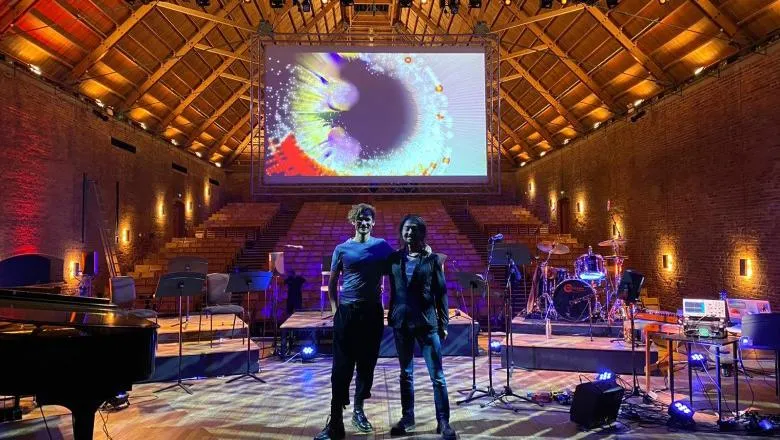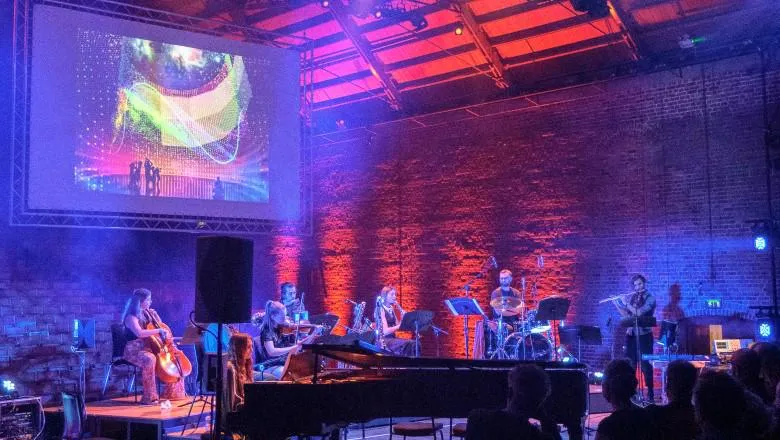We still don’t know much about cosmic rays, where they come from and how they reach this kind of energy and their study is very important for humanity. So, it is really special for musicians to be responding to live cosmic ray data, reacting, in other words, to what the universe is giving in real time.
Teppei Katori, experimental particle physicist and Reader at King’s
20 December 2021
Subatomic – King's Artists project explores the connection between art and astrophysics
How can musical composition and astrophysics work together to inform research and increase understanding of the complex phenomenon of cosmic rays?

Written by Samantha Seto, PhD student in the Department of English, Faculty of Arts & Humanities and student digital content coordinator, King’s Culture
My recent experience with Subatomic, a performance resulting from the first phase of the King’s Artist collaboration between composer Christo Squier and astrophysicist Dr Teppei Katori, provides some insight into an exciting project addressing this important question.
King’s artist-in-residence Christo Squier is working in collaboration with Dr Teppei Katori, experimental particle physicist and Reader in the Department of Physics in the Faculty of Natural, Mathematical & Engineering Sciences on a project about the subatomic world of cosmic rays. The project combines scientific research with artistic performance to analyse and visualise these high energy particles from outer space. More specifically, Christo and Teppei are exploring an intelligence-based response to cosmic rays via musical performance, composition, sonification, and computer visualisation.
The first phase of the collaboration culminated with the first iteration of Subatomic, a performance ‘part experiment, part lecture, part suite of new music’ which took place in Britten Pears Arts Festival of New at Snape Maltings, where Christo completed a week-long residency.
In my role as a student digital coordinator, I had the chance to watch the performance in the online version of the festival. The beautiful music played by Christo, Teppei and an ensemble of instrumentalists expressed the duality between music and the cosmos and emphasised the new hope of scientific discovery derived from a project that combines art with physics.

The Subatomic performance centres on the audio-visual demonstration of cosmic rays, high-energy particles, that are blasted from supernovae of the galaxy and other astrophysical phenomena in the universe. The musical compositions were built using scientific data coming from the Super-Kamiokande neutrino observatory, situated inside a mountain of rural Japan. Creative technologist Chris Ball, working alongside Christo and Teppei, found a way to convert this data into sound. While some musical pieces were built using pre-recorded data, others were improvised with data pulled live during the performance. Moreover, a device called a ‘cosmic watch’, detected cosmic rays and generated signals that eventually dictated the colours and brightness within the concert hall.
It just absolutely blew my mind that we were pulling live data from this experiment that has won various Nobel prizes, hidden in a mountain in Japan, to my computer, using music software to make musical chords.
Christo Squier, composer & multi-disciplinary artist
Christo and Teppei are now preparing for the performance of the next phase of Subatomic. Moving forward, their aim is to create a virtual environment based upon the interior of a cosmic ray detector, which will transmute the data into immersive audio-visual experiences creating the feeling of a ‘cosmic calling response’. Through the visual and performance art project which would involve an installation processing data in real time, they hope to stir curiosity in the fascinating subject of astrophysics, particle physics, and related research at King’s College London. Follow Christo and Teppei on Twitter for future updates on their project.
It is really challenging for the performers to improvise with live data because you can’t know when cosmic rays will be detected. But then, it is incredible to feel that your performance is the response to what the universe is giving you.
Teppei Katori, experimental particle physicist & Reader at King’s
Christo and Teppei’s project is part of the King’s Artists 2021 cohort exploring the theme of ‘Intelligence’. Out of eleven new collaborative R&D projects across four King’s College London faculties, six have been selected to receive extra funding to further develop their projects.
Read about other King’s Artists projects from the 2021 ‘Intelligence’ cohort:
King’s Artists provides opportunities for artists to be resident within faculties across the university and aims to support residencies that place collaboration with students and staff across disciplines to embrace creativity and take risks, developing new thinking and creative outputs.
King’s has a long history of hosting and working with artists across its faculties and within its wide range of research areas, bringing together nearly 60 artist residences that have connected academic research with art through a range of media including painting, printing, literature, theatre, music, performance, installation, photography, video, textiles, waxwork modelling, ceramics and fashion. Many of the artists and academics have presented the work and research developed at King’s during residencies on national and international platforms.
Samantha explores cultural London on Instagram. Follow @CulturalKings to read her recommendations.
